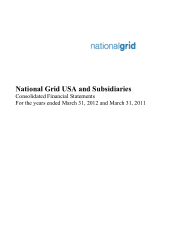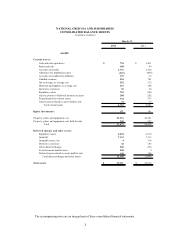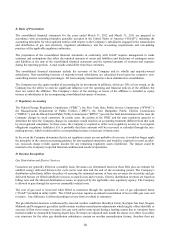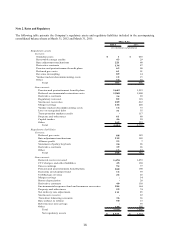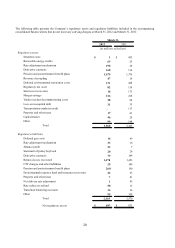National Grid 2012 Annual Report Download - page 11
Download and view the complete annual report
Please find page 11 of the 2012 National Grid annual report below. You can navigate through the pages in the report by either clicking on the pages listed below, or by using the keyword search tool below to find specific information within the annual report.10
B. Basis of Presentation
The consolidated financial statements for the years ended March 31, 2012 and March 31, 2011 are prepared in
accordance with accounting principles generally accepted in the United States of America (“GAAP”), including the
accounting principles for rate-regulated entities with respect to the Company’ s subsidiaries engaged in the transmission
and distribution of gas and electricity (regulated subsidiaries), and the accounting requirements and rate-making
practices of the applicable regulatory authorities.
The preparation of the consolidated financial statements in conformity with GAAP requires management to make
estimates and assumptions that affect the reported amounts of assets and liabilities and disclosure of contingent assets
and liabilities at the date of the consolidated financial statements and the reported amounts of revenues and expenses
during the reporting periods. Actual results could differ from those estimates.
The consolidated financial statements include the accounts of the Company and its wholly and majority-owned
subsidiaries. Non-controlling interests of majority-owned subsidiaries are calculated based upon the respective non-
controlling interest ownership percentages. All intercompany transactions have been eliminated in consolidation.
The Company uses the equity method of accounting for its investments in affiliates, which are 50% or less owned, as the
Company has the ability to exercise significant influence over the operating and financial policies of the affiliates but
does not control the affiliates. The Company’ s share of the earnings or losses of the affiliates is included as equity
income in subsidiaries in the accompanying consolidated statements of income.
C. Regulatory Accounting
The Federal Energy Regulatory Commission (“FERC”), the New York State Public Service Commission (“NYPSC”),
the Massachusetts Department of Public Utilities (“DPU”), the New Hampshire Public Utilities Commission
(“NHPUC”), and the Rhode Island Public Utility Commission (“RIPUC”) provide the final determination of the rates the
Company charges its retail customers. In certain cases, the actions of the FERC and the state regulatory agencies to
determine the rates the Company charges its customers would result in an accounting treatment different from that used
by non-regulated companies. In these cases, the Company is required to defer costs (regulatory assets) or to recognize
obligations (regulatory liabilities) if it is probable that these amounts will be recovered or refunded through the rate-
making process, which would result in a corresponding increase or decrease in future rates.
In the event the Company determines that its net regulatory assets are not probable of recovery, it would no longer apply
the principles of the current accounting guidance for rate-regulated enterprises and would be required to record an after-
tax, non-cash charge (credit) against income for any remaining regulatory assets (liabilities). The impact could be
material to the Company’ s reported financial condition and results of operations.
D. Revenue Recognition
Gas Distribution and Electric Services
Customers are generally billed on a monthly basis. Revenues are determined based on these bills plus an estimate for
unbilled energy delivered between the cycle meter read date and the end of the accounting period. The Company’ s
distribution subsidiaries follow the policy of accruing the estimated amount of base rate revenues for electricity and gas
delivered but not yet billed (unbilled revenues), to match costs and revenues. Electric distribution revenues are based on
billing rates and the allowed distribution revenue, as approved by the applicable state regulatory agency. The Company
is allowed to pass through for recovery commodity-related costs.
The cost of gas used is recovered when billed to customers through the operation of cost of gas adjustment factor
(“CGAF”) included in utility tariffs. The CGAF provision requires an annual reconciliation of recoverable gas costs and
revenues. Any difference is deferred pending recovery from or refund to customers.
The gas distribution business is influenced by seasonal weather conditions. Brooklyn Union, KeySpan Gas East, Niagara
Mohawk and Narragansett gas utility tariffs contain weather normalization adjustments which largely offset shortfalls or
excesses of firm net revenues (revenues less gas costs and revenue taxes) during a heating season due to variations from
normal weather as measured by heating degree days. Revenues are adjusted each month the clause is in effect. Gas utility
rate structures for the other gas distribution subsidiaries contain no weather normalization feature; therefore their net

